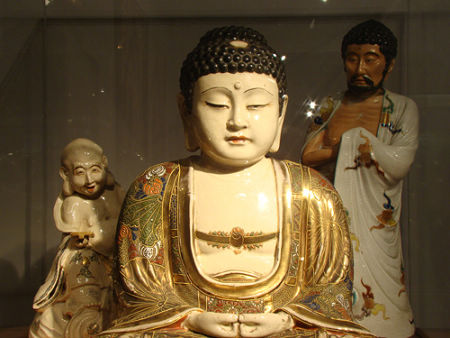Making a museum
With China witnessing a boom in non-governmental museums in recent years, many institutions are facing problems in development.
The World Urbanism and Museums Forum held Friday in Beijing discussed several success strategies, with the example of a small French museum offering a way out for ailing museums of this kind in China.
|
Pieces from the collection at the Museum of Oriental Art. |
Zhu Xintian, vice-director of the Museum of Oriental Art in Biarritz, southwestern France, gave details about managing the small but unique French museum during her speech at the forum. Michel Postel, director and founder of the museum, talked about his experiences in operating the museum in an exclusive interview with the Global Times after Zhu, his wife, finished her speech.
"I think you need to figure out what the audiences need when opening a museum," Postel said, citing that he noticed in China, there are enthusiastic collectors of jade with large-scale collections, but no jade museum, neither government sponsored, nor non-governmental.
Postel's Museum of Oriental Art was designed for lovers of ancient Oriental art and culture and was established due to his great appreciation and love for ancient Asian artifacts.
With a display area of around 1,000-square-meters, the museum has held more than 100 exhibitions since opening in 1999. It also owns over 1,000 ancient works of art from Asia, including India, Nepal and China, with some items very precious and rare.
"I wanted to provide French people with an opportunity to understand Oriental art," Postel explained. "In France there are lots of stories about the mystical Orient, but few of them have the chance to go there."
Located in the luxurious coastal town of Biarritz, every year, thousands of visitors from across Europe spend hours a day at the museum.
Postel, 84, went to India in 1947 to open a pharmaceutical company there. He fell in love with Indian art and started to collect traditional pieces. Gradually he extended his collection to other neighboring countries such as China and Nepal and is fascinated with the study of inner links among the cultures.
His museum is considered by many in Europe as a window to Oriental art and culture, with many papers and books about the works and the cultures behind them published by the museum.
Postel explained that aside from selecting an interesting focus, small museums should be a pleasure to be in, information should be easily accessible and the displays attractive and inviting.
"Many come to the museum with the aim to study, not just to view in a hurry and then leave," Zhu said in her speech. "Our museum is the only one of its kind, where the visitor may spend hours in enriching himself."
 0
0 








Go to Forum >>0 Comments